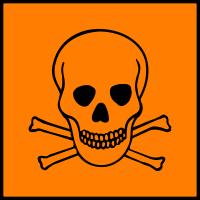NAMES AND DATABASE IDS
NAMES AND DATABASE IDS
Names Database IDs
|
IUPAC name
|
|
|
IUPAC Systematic name
|
|
Oxidonitrogen(?) (additive)
|
|
|
|
|
IUPAC Traditional name
|
|
|
Brand Name
|
|
Amidogen, oxo-
|
|
INOmax
|
|
Mononitrogen monoxide
|
|
NMO
|
|
NO
|
|
Nitric oxide 10% by volume or more
|
|
Nitric oxide trimer
|
|
Nitrogen monooxide
|
|
Nitrogen monoxide
|
|
Nitrogen oxide
|
|
Nitrosyl radical
|
|
RCRA waste number P076
|
|
nitrogen protoxide
|
|
|
|
|
Synonyms
|
|
Nitric Oxide
|
|
Nitric oxide
|
|
Nitrogen monoxide
|
|
Nitrogen(II) oxide
|
|
氧化氮
|
|
一氧化氮
|
|
|
|
|
CAS Number
|
|
|
EC Number
|
|
|
MDL Number
|
|
|
PubChem SID
|
|
|
PubChem CID
|
|
|
CHEBI ID
|
|
|
ATC CODE
|
|
|
CHEMBL
|
|
|
Chemspider ID
|
|
|
DrugBank ID
|
|
|
Gmelin ID
|
|
|
KEGG ID
|
|
|
Unique Ingredient Identifier
|
|
|
Wikipedia Title
|
|
DATA SOURCES
DATA SOURCES
All Sources Commercial Sources Non-commercial Sources
CALCULATED PROPERTIES
CALCULATED PROPERTIES
JChem
|
H Acceptors
|
1
|
H Donor
|
0
|
LogD (pH = 5.5)
|
-0.3514
|
LogD (pH = 7.4)
|
-0.3514
|
Log P
|
-0.3514
|
Molar Refractivity
|
2.8858 cm3
|
Polarizability
|
1.69344 Å3
|
Polar Surface Area
|
34.14 Å2
|
Rotatable Bonds
|
0
|
Lipinski's Rule of Five
|
true
|
PROPERTIES
PROPERTIES
Physical Property
Safety Information
Pharmacology Properties
Product Information
Bioassay(PubChem)
|
Solubility
|
|
74 cm3 dm-3 in water
|
 Show
data source Show
data source
|
|
9.49E+004 mg/L
|
 Show
data source Show
data source
|
|
|
Apperance
|
|
Colourless gas
|
 Show
data source Show
data source
|
|
|
Melting Point
|
|
-163.6 °C(lit.)
|
 Show
data source Show
data source
|
|
-164°C
|
 Show
data source Show
data source
|
|
|
Boiling Point
|
|
-151.7 °C(lit.)
|
 Show
data source Show
data source
|
|
-152°C
|
 Show
data source Show
data source
|
|
|
Density
|
|
1.3402 g dm-3
|
 Show
data source Show
data source
|
|
|
Refractive Index
|
|
1.0002697
|
 Show
data source Show
data source
|
|
|
Vapor Density
|
|
1.05 (vs air)
|
 Show
data source Show
data source
|
|
|
Hydrophobicity(logP)
|
|
0
|
 Show
data source Show
data source
|
|
|
Std enthalpy of formation
|
|
90.29 kJ mol-1
|
 Show
data source Show
data source
|
|
|
Std molar entropy
|
|
210.76 J K-1 mol-1
|
 Show
data source Show
data source
|
|
|
RTECS
|
|
QX0525000
|
 Show
data source Show
data source
|
|
|
European Hazard Symbols
|
 Oxidising (O) Oxidising (O)
|
 Show
data source Show
data source
|
 Toxic (T) Toxic (T)
|
 Show
data source Show
data source
|
|
|
UN Number
|
|
1660
|
 Show
data source Show
data source
|
|
|
MSDS Link
|
|
|
German water hazard class
|
|
1
|
 Show
data source Show
data source
|
|
|
Hazard Class
|
|
2.3
|
 Show
data source Show
data source
|
|
|
Risk Statements
|
|
8-23-34-44
|
 Show
data source Show
data source
|
|
R8, R23, R34, R44
|
 Show
data source Show
data source
|
|
|
Safety Statements
|
|
17-23-36/37/39-45
|
 Show
data source Show
data source
|
|
S1, S17, S23, S36/37/39, S45
|
 Show
data source Show
data source
|
|
|
GHS Pictograms
|

|
 Show
data source Show
data source
|

|
 Show
data source Show
data source
|

|
 Show
data source Show
data source
|
|
|
GHS Signal Word
|
|
Danger
|
 Show
data source Show
data source
|
|
|
NFPA704
|
|
|
 Show
data source Show
data source
|
|
|
GHS Hazard statements
|
|
H270-H314-H331
|
 Show
data source Show
data source
|
|
|
GHS Precautionary statements
|
|
P220-P261-P280-P305 + P351 + P338-P310
|
 Show
data source Show
data source
|
|
|
Personal Protective Equipment
|
|
Faceshields, Gloves, Goggles, half-mask respirator (US), multi-purpose combination respirator cartridge (US)
|
 Show
data source Show
data source
|
|
|
RID/ADR
|
|
UN 1660 2.3
|
 Show
data source Show
data source
|
|
|
Admin Routes
|
|
Inhalation
|
 Show
data source Show
data source
|
|
|
Bioavailability
|
|
good
|
 Show
data source Show
data source
|
|
|
Half Life
|
|
2–6 seconds
|
 Show
data source Show
data source
|
|
|
Metabolism
|
|
via pulmonary capillary bed
|
 Show
data source Show
data source
|
|
|
Purity
|
|
98.5%
|
 Show
data source Show
data source
|
|
|
Linear Formula
|
|
NO
|
 Show
data source Show
data source
|
|
DETAILS
DETAILS
 DrugBank
DrugBank
 Wikipedia
Wikipedia
 Sigma Aldrich
Sigma Aldrich
DrugBank -
DB00435

|
| Item |
Information |
|
Drug Groups
|
approved |
|
Description
|
Nitric oxide or Nitrogen monoxide is a chemical compound with chemical formula NO. This gas is an important signaling molecule in the body of mammals including humans and is an extremely important intermediate in the chemical industry. It is also a toxic air pollutant produced by automobile engines and power plants.
Nitric oxide (NO) should not be confused with nitrous oxide (N2O), a general anaesthetic, or with nitrogen dioxide (NO2) which is another poisonous air pollutant.
The nitric oxide molecule is a free radical, which is relevant to understanding its high reactivity. It reacts with the ozone in air to form nitrogen dioxide, signalled by the appearance of the reddish-brown color. |
| Indication |
For the treatment of term and near-term (>34 weeks) neonates with hypoxic respiratory failure |
| Pharmacology |
Persistent pulmonary hypertension of the newborn (PPHN) occurs as a primary developmental defect or as a condition secondary to other diseases such as meconium aspiration syndrome (MAS), pneumonia, sepsis, hyaline membrane disease, congenital diaphragmatic hernia (CDH), and pulmonary hypoplasia. In these states, pulmonary vascular resistance (PVR) is high, which results in hypoxemia secondary to right-to-left shunting of blood through the patent ductus arteriosus and foramen ovale. In neonates with PPHN, Nitric oxide improves oxygenation (as indicated by significant increases in PaO2). Nitric oxide appears to increase the partial pressure of arterial oxygen (PaO2) by dilating pulmonary vessels in better entilated areas of the lung, redistributing pulmonary blood flow away from lung regions with low ventilation/perfusion (V/Q) ratios toward regions with normal ratios. |
| Affected Organisms |
| • |
Humans and other mammals |
|
| Biotransformation |
via pulmonary capillary bed |
| Absorption |
Nitric oxide is absorbed systemically after inhalation. |
| Half Life |
2–6 seconds |
| Elimination |
Nitrate has been identified as the predominant nitric oxide metabolite excreted in the urine, accounting for >70% of the nitric oxide dose inhaled. |
| References |
| • |
Pacher P, Beckman JS, Liaudet L: Nitric oxide and peroxynitrite in health and disease. Physiol Rev. 2007 Jan;87(1):315-424.
[Pubmed]
|
|
| External Links |
|
|
Sigma Aldrich -
295566

|
Packaging
17 L in steel cylinder
Recommended products
Stainless steel control valves Z146951, Z187224 or either of stainless steel regulators Z148504 and Z148512 and a "T"-purge valve Z151661 is recommended. |
PATENTS
PATENTS
 PubChem Patent
PubChem Patent
 Google Patent
Google Patent
